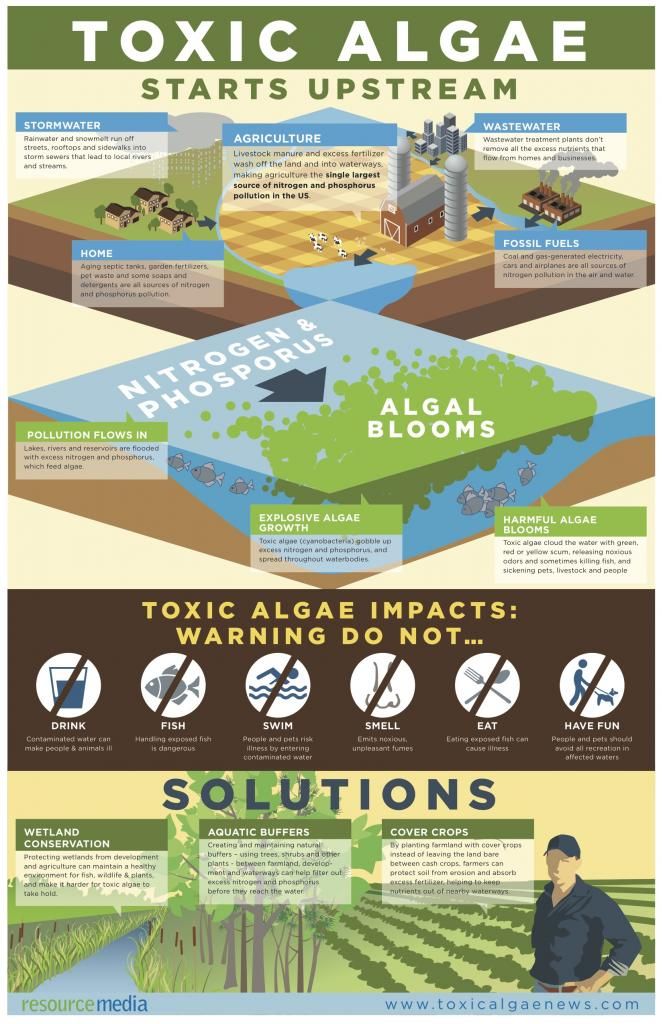The Iowa House and Senate wrapped up the 2014 session during “Soil and Water Conservation Week.” While certain environmental programs did well in the budget for fiscal year 2015, the legislature did not adequately address some of the biggest problems affecting Iowa’s soil and water.
The Iowa Environmental Council blog linked to several recent articles by “top experts on Iowa soil conservation,” who “expressed alarm about the state of our soil” and in particular the rapid rate of erosion. Along with other kinds of agricultural runoff, soil erosion contributes to toxic algae blooms in rivers and lakes, not only in Iowa and neighboring states but also across much of the U.S. Nutrient pollution is a major reason that more than half of the country’s rivers and streams are “in poor condition for aquatic life.”At the end of this post, I’ve enclosed an infographic explaining how toxic algae blooms form and how to prevent them.
Iowa lawmakers continue to throw money at the state’s Nutrient Reduction Strategy, without insisting on numeric criteria for nitrogen and phosphorous levels in water and without the goals, timelines and monitoring needed to assure Iowans that waterways are becoming cleaner. In fact, the fiscal year 2015 appropriation for the Iowa Department of Agriculture and Land Stewardship removed wording requiring that money for watershed projects be used to reduce nutrients. Follow me after the jump for the disturbing details.
From the beginning, Iowa Secretary of Agriculture Bill Northey has insisted on an all-voluntary approach to reducing excessive nutrients that leach from “non-point sources” (primarily agriculture) into Iowa waterways. He rejected suggestions from the U.S. Environmental Protection Agency and others who warned that without numeric criteria for phosphorus and nitrogen, the Nutrient Reduction Strategy would fail. Northey resisted any mandatory regulations for farmers as well as calls for more accountability to help Iowans find out which, if any, watershed projects were actually reducing water pollution. Environmental advocates including the Iowa Environmental Council, with which I’m involved, would like to see “a more targeted voluntary incentive program” that focuses state budget funds where they will do the most good for clean water.
Northey strongly supports the Nutrient Reduction Strategy, as long as no farmer is forced to do anything and no one can evaluate the strategy’s success in a meaningful way. Within those parameters, he was a big advocate for IDALS-funded watershed projects. In fact, he requested an extra $2.25 million in state funding for the Iowa water quality initiative. Northey’s proposal would have raised spending in this area to $6.65 million for fiscal year 2015. However, Governor Terry Branstad’s draft budget and the bill Iowa lawmakers approved last week allocated $4.4 million for the initiative (see pages 6 through 8 of House File 2458, the appropriations bill for agriculture and natural resources).
The big problem is not the amount of funding, but the lack of strings attached. At an Iowa House hearing in January, Democratic State Representative Dan Kelley was one of the few lawmakers asking Northey and Department of Natural Resources Director Chuck Gipp tough questions.
Rep. Dan Kelley, D-Newton, however, criticized the strategy for its lack of measurable outcomes. His concerns echoed those of environmental groups that have asked for additional requirements in Iowa’s law.
“More and more, people are concerned about water quality,” Kelley said. “We don’t have timelines, targets, benchmarks or the like. Who’s responsible for developing those? Where are those?”
Northey said it would be hard to put benchmarks in place without the Legislature promising to allocate a specific amount of money each year.
Gipp added he wouldn’t want to set “unrealistic expectations” one year and then have funding cut the next.
“You have to understand the immensity of the issue,” he said.
“In order for us to be a leader, we need quantifiable and measurable efforts,” Kelley shot back.
Really, Secretary Northey and Director Gipp? Because we don’t know future funding levels, we should shut our eyes to which projects are doing the job and which are just wasting taxpayer money?
As mentioned above, House File 2458 allocated $4.4 million toward IDALS watershed projects in the coming fiscal year, which begins July 1. Whether that money will be spent effectively is anyone’s guess. During the legislative process in the Iowa House, lawmakers removed language requiring that watershed funds be “used to support reducing nutrients.” Instead, they can be used for any kind of watershed project.
Furthermore, the House-approved bill directed the agriculture department to evaluate water quality in the “supported watersheds” but stipulated that “any information” collected for the database on water quality would be considered a “confidential record […] exempted from public access.” (see page 7 of the bill). In other words, no one would be able to find out whether water was becoming cleaner where IDALS was spending money. Iowa would continue to fly blind in its nutrient reduction strategy.
Environmental groups lobbied against the secrecy language, and the conference committee report on this appropriations bill was a slight improvement. Only information that could identify a specific farm or agricultural land owner will be considered a confidential record. Still, the bill raises questions about how much outsiders will be able to learn about the impact of IDALS watershed projects.
Please share any relevant comments in this thread.

